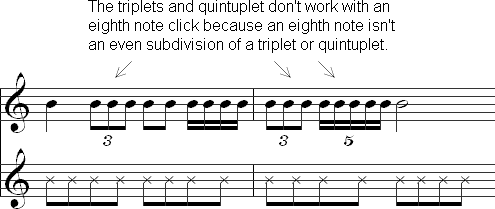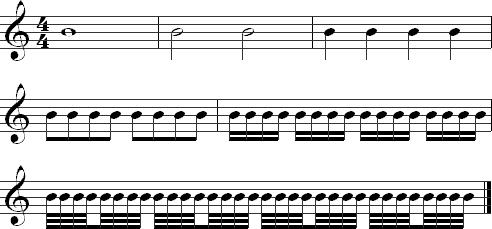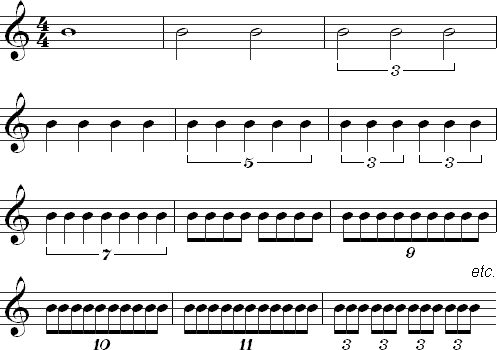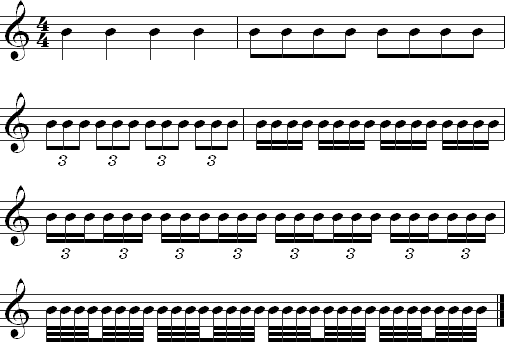What You Should Know
What You Will Learn
- What a metronome is and how to use it
- How to read metronome markings
- Tips for using a metronome to gain speed
Learn How to Practice with a Metronome
Practicing with a metronome is the best way to develop speed and a rock-solid sense of time. A metronome makes it easy to increase your speed in a gradual way. Many players avoid metronomes because they don't know how to use one. This is unfortunate because a metronome can simplify even the most difficult music so that it becomes relatively easy to learn. There are various approaches to using a metronome. Each of these has pros and cons and some may work in a situation where another wouldn't.
What is a Metronome?
A metronome is a device that provides a repeating click that allows you to keep time. The speed of the click can be adjusted to allow you to play different tempos. The tempo is the speed of the music.
The speed of a metronome click is calculated in beats per minute (bpm). Most metronomes have a range of tempos starting at 40 and going up to around 200. Each of these numbers indicates how many beats per minute at that tempo. The lower the number, the slower the tempo. For example, setting the metronome to 60 means that there are 60 beats per minute.
Modern music often includes metronome marks in the music to specify a tempo. A metronome mark usually includes a note value, an equal sign, and a number.
- 1. The note value indicates which note corresponds to each click of the metronome.
- 2. The number indicates how many beats per minute. This is the number you use for setting your metronome.
The example below shows a metronome marking of quarter = 120. This means that the metronome should be set to 120. Each click of the metronome will be a quarter note.

Getting Started with a Metronome
It will likely take you some time to become comfortable with using a metronome. The click may seem like an annoyance at first and you may ignore it. Listen to the click before you play anything and become familiar with the tempo. Once you start playing, don't just ignore the metronome. You need to learn to hear the metronome and play along with it.
If you have never used a metronome before, try the simple exercises below to become accustomed to playing with it before you apply it to an entire practice session.
Exercises
Exercise 1
Set the tempo of the metronome to 60. The click will be a quarter note. Turn the metronome on. Listen to the click and start counting along in 4/4. Once you can feel the beat, start clapping with the metronome as you count. Try to completely cover the click with the sound of your clapping. This isn't a matter of playing louder than the click--you need to play exactly with the click. You shouldn't come in early or late.

After you are able to play this exercise at 60bpm. Try playing the exercise again, but with the metronome set to 40, 80, 120, and other tempos.
Exercise 2
This is similar to exercise 1, except you will be strumming an E major chord. Start at 60bpm and then try the exercise at other tempos.

If you are able to play these simple exercises, you should be ready to start using the metronome when you practice.
Start Slowly
If you are trying to build up speed with the metronome, you need to start very slowly. Choose a tempo that is even slower than you think you need to go. If the tempo is too slow, you will easily increase the tempo to a speed that challenges you. When you start too fast, you may be developing bad habits, so going too slow is better than going too fast. You will likely develop the ability to determine the appropriate tempo as you work with a metronome more.
Playing at a very slow tempo can be boring if you don't do it right. Extremely slow tempos give you the opportunity to become aware of each note and every movement required to play those notes. Use slower tempos to economize your movement and eliminate tension.
Practice Journal
Using a metronome effectively requires you to track your practice. The best way to do this is to keep a daily practice journal. A journal will allow you to monitor how you are progressing by keeping track of metronome speeds on whatever you practice. Each day, you should write down the fastest tempo where you were able to play perfectly. This tempo should be the tempo you try to exceed in your future practice sessions. You shouldn't start at that tempo, but try to reach it by the end of your practice session if possible. For example, if you reach a tempo of 120bpm with whatever you are practicing, your next goal could be to get to 126bpm.
The Click
The click of the metronome will usually represent a single beat in the music you are playing. In 4/4, this will be a quarter note, while in 6/8 it would be a dotted quarter note. The click doesn't always have to correspond to a beat. It could represent a note value that is smaller or larger than the beat. For example, if you have a passage in sixteenth notes in 4/4, you might want the metronome to represent an eighth note or even a sixteenth note. This allows you to use slower tempos and have more clicks to help keep your timing even.
The click also may represent a larger note value. For example, a single click could represent a dotted half note in 3/4.
Note that using the click for something other than a single beat poses certain problems if there are a lot of mixed rhythms. For example, it would be difficult to use an eighth note click in 4/4 if you have rhythms that include eighth note triplets and sixteenth note quintuplets.

Practice without the Metronome
Practicing without the metronome is beneficial some of the time. If you have just started working on learning something new, the metronome may hinder your progress. The early stage of learning a new piece generally involves figuring out fingerings, picking patterns, and other things. This should be a time of experimentation, so don't turn on the metronome until you have worked these things out.
The metronome should also not be used as a crutch for your lack of rhythm. The goal of using the metronome is to develop your sense of timing and ability to keep a steady tempo. If you can't do this without a metronome, you need to work without it more often. An exercise you can try is creating a click track with a measure of clicks and a measure of rest. This way, you have to keep a steady tempo during the measures of rest without a click to reference. If you don't come in exactly with the next click after a measure of rest, you need to practice exercises like this more often.
A click track is a simple click, similar to a metronome, that is used in recording to enable musicians to play in time with each other even though their parts may have been recorded at different times.
Below is an audio example of a click track in 4/4. There are four clicks followed by four beats of rest. This pattern repeats several times. Try counting along with the track to see if you can keep a steady tempo. You need to maintain the tempo through the beats of rest. If you are coming in before or after the click, you need to work on developing your internal sense of time.
Approaches to Using the Metronome
Start Slowly and Gradually Increase the Speed
The most basic way of using the metronome is to start at a slow tempo and gradually increase the speed as you are able to play something at each tempo. The tempo should only be increased once you feel comfortable at the current tempo and can play a passage perfectly at that tempo. You may even want to challenge yourself by saying that once you play something perfectly five times in a row, you can increase the tempo.
The downside of this approach is that playing slow is different than playing fast in more ways than just the tempo. You can be leisurely and careless about your movements at a slow tempo, but to go faster, you need to economize and control your movement much more precisely.
Alternating Slow and Fast Tempos
Another approach is to alternate slow playing with fast playing. This often results in quicker results, but could lead to bad habits if you focus on going fast more than playing accurately with correct technique.
The slower practice allows you to refine your technique and pay attention to excess tension. Faster tempos allow you to think in terms of bigger movements rather than worrying about every single note. This can help you determine whether a fingering or position of your hand or arm will work at your goal tempo or not.
The basic concept is to set two different tempos: a base tempo and a target tempo. The base tempo is the slow tempo. It will increase throughout your practice. This is the tempo where you should be playing perfectly. The target tempo is the tempo at which you want to play something. Below is a detailed breakdown of this approach:
- 1. Set a base tempo and a target tempo. The base tempo could be 60 and the target tempo 120.
- 2. Start by playing the music at 60bpm.
- 3. Increase the metronome to 120bpm and play the passage again. You will probably be pretty sloppy at this tempo.
- 4. Lower the tempo to slightly more than your original base tempo. Since you started at 60, try setting the metronome to 66bpm and playing the passage again.
- 5. Repeat steps 3 and 4, increasing the base tempo each time, until your base tempo equals the target tempo. You should find that the target tempo feels somewhat easier even if you still can't quite manage it.
The steps above may be done over several days, weeks, or even months. The increase in the base tempo doesn't need to happen in a single practice session.
Subdividing
Another way of increasing your speed with the metronome is by subdividing the note values and keeping the click at the same speed. You could subdivide by starting with quarter note, moving to eighth notes, then sixteenth notes. You are still playing at the same tempo, but have increased your speed through playing progressively smaller note values. This is a good way to improve your sense of timing.
Note that this approach works best with exercises like scales and arpeggios, but could be applied to actual music as long as it contains steady rhythms, such as a constant stream of eighth notes.
There are a few different ways you can subdivide.
Alternating Between Two Rhythms
You can alternate between two rhythms, one that is half the value of the other. For example, alternating between eighth and sixteenth notes:

Subdividing by Two
Try subdividing by a certain number over and over again. The simplest example of this is subdividing by two. The example below shows how dividing by two takes you from whole notes to thirty-second notes:

Polyrhythms
Add one note to each measure while keeping each note value equal to the others. This is very difficult because it involves a lot of complex polyrhythms. However, if you are interested in complex rhythms, this can be good practice for learning to play them. Below is an example of subdivisions from whole notes to eighth note triplets.

Subdividing with Common Rhythms
Another approach is to use a mixture of common rhythms. This is probably the most practical since these are rhythms that are common in much of the music you will play.

You can easily come up with many more combinations on your own. The basic concept is to start with a large note value and then gradually play smaller note values through subdividing the larger note value.
Recommended Metronomes
There are several free metronome programs that you can run on your computer. These vary in quality and aren't portable, so if you need more features and want something portable, you should purchase a metronome.
- 1. Weird metronome (recommended)
- 2. Metronomes for the Mac
- 3. Metronomes for Windows
If you want a portable metronome, you have many options. There are metronomes that only provide a basic click with a dial to set the tempo. Other metronomes allow you to specify different sounds, time signatures, and more. My experience is that simple dial metronomes are often the easiest to work with and tend to last longer.
